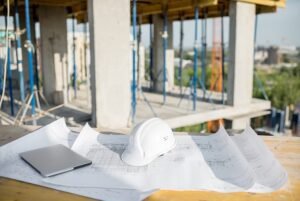We define a construction takeoff as “the estimating of quantities for a contract from plans and drawings which are then reported in the bill of quantities”. In reality, however, a quantity takeoff is to represent one of its most essential functions: the process by which a cost estimator evaluates a set of plans during preconstruction and “takes off” measures from these plans to anticipate construction costs. During a takeoff, estimators “take off” data from standard contract documents such as architectural designs, structural engineering drawings, plumbing drawings, site water reticulation and drainage plans, electrical drawings, and HVAC drawings.
Although material takeoffs are widespread in the industry, there are still considerable misconceptions about the procedure. For example, many people believe that a quantity takeoff is exclusively for estimating materials or that the process comprises evaluating a set of project designs and then quantifying information about the physical components. However, a material takeoff does not involve directly estimating materials.
What Is Quantity Takeoff In Construction?
A quantity takeoff is the process of quantifying a project’s work in the form of a set of quantifiable work items that contain both labor and materials. Again, the focus is on the work rather than the materials.
The misunderstanding around quantity takeoff originates from the fact that various names frequently refer to takeoffs. These are
Takeoff or takeoff
Quantity takeoff
Materials takeoff
Construction takeoff
Material estimating
Material counts
Quantity Surveying
Material Takeoff And Quantity Takeoff

The thorough estimating process described above is significantly more likely to yield a price that accurately forecasts the actual costs of developing a construction project than a material takeoff; yet, the construction takeoff provides the necessary foundation for an accurate work assessment, which can only be achieved if the project owner supplies an estimator and blueprints. The confusion over quantity takeoff originates from the fact that multiple names frequently refer to takeoffs.
For A Successful Quantity Takeoff What Do We Require?
A construction takeoff is the first step in creating a thorough estimate. For a takeoff to take place, an estimator requires these things.
Define the takeoff scope:
Measure every item:
Keep track of quantities:
However, larger projects require a more thorough plan to manage the sheer volume of items to measure and count. In these cases, an estimator should break down the project into smaller, more manageable chunks and then focus on one aspect at a time. The type of project determines how an estimator divides it into manageable chunks. High-rise structures, for example, can be simply separated into floors or groups of floors. Some projects can be broken down into zones, phases, or even individual buildings.
Many cost estimators also keep a database of typical items on a wide range of projects, although it is not uncommon. The catalog of standard work items is a checklist throughout the takeoff process, particularly by junior estimators, to ensure that all general categories of work have been considered in the estimate.
In most cases, the project scope is already defined. That is what comes with complete blueprints: the spec sheets. To correctly estimate, you need to follow a set of rules—a standard of sorts. This way, pricing the job becomes necessary and simpler.
Why Is It Important To Do A Quantity Takeoff?
Material takeoffs contribute significantly to cost estimation. The precision of construction takeoffs is in the total building cost.
Cost tracking
Correct takeoffs make it easier to track construction expenses. You have a clear view of how much money you need to spend, which aids decision-making and prevents budget overruns. Accurate construction takeoffs also allow you to account for unanticipated charges. All building elements are labor, equipment, and materials.
Communication
Everything in the building comes down to cost. Clients are constantly looking for methods to make the most of their money. Accurate cost estimates promote straightforward communication, which keeps clients informed. This, in turn, leads to earning the client’s trust. The client will be able to track the project’s progress and expenses.
Winning More Bids
To ensure you win the correct bids, thoroughly research and prepare your cost estimates to give yourself an advantage over your competition. A contractor’s consistency in providing precise takeoffs demonstrates their efficiency at work, and hence, they will win more bids.
Types Of Quantity Takeoffs To Work With
The introduction of technology in the construction industry has transformed how we execute material takeoffs. However, this does not erase the human aspect of takeoffs. We have two major forms of construction takeoffs, which are
Manual takeoffs.
This is the oldest material takeoff form. When a construction estimator calculates an estimate without using cost estimation software, they employ the manual takeoff method, even if they use Excel spreadsheets or Microsoft Word processors. At the most fundamental level, manual estimates entail analyzing the scope of work and specifications as stated in contract drawings and papers.
Digital takeoffs
Digital takeoffs employ computer and database applications to help estimate the costs of the construction project. These are faster and more efficient than manual takeoffs.
Quantity Takeoff Example

Like all other parts of construction, performing a material takeoff is a talent that develops over time and with practice. The takeoff formula is divided into two parts: input and output, whether done digitally or manually. We can do takeoffs manually.
Input
To achieve a high volume of takeoffs, you must feed accurate data into your takeoff models. Whether you work by hand or digitally, it is critical to handle your input correctly. You can employ software tools to generate high-quality planning solutions.
Output
The output stage translates the concepts supplied in the data into the project’s physical requirements. This is where actual estimates and figures bring a project to life. Precise material estimations are also critical at this point.
What Is Not In The Quantity Takeoff?
To avoid errors in quantity takeoff, the estimator should be aware of various elements that do not need to be included in the calculations. Some numbers are addressed later in the overall cost assessment process. Construction takeoffs do not include some of the following data:
Transportation costs.
Loading and unloading costs
Scaffolding
Lapping and Waste Materials
Stripping formwork
Conclusion
As previously said, Quantity takeoff is an essential procedure for accurately estimating costs in a building project. There are two distinct construction takeoff approaches for generating estimations. However, digital procedures are increasingly gaining traction and popularity due to their additional benefits, such as minimizing errors and waste while enhancing accuracy and efficiency. Takeoffs are to determine the overall project scope and budget. Adopting the correct technology provides a realistic picture of what is required to fulfil a project’s aim.






